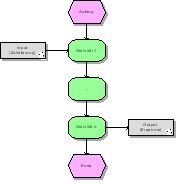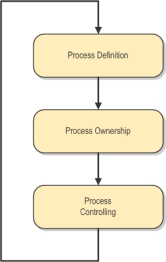Process Management: Difference between revisions
mNo edit summary |
No edit summary |
||
| (3 intermediate revisions by the same user not shown) | |||
| Line 1: | Line 1: | ||
< | <itpmch><title>Process Management | IT Process Wiki</title> | ||
<meta name="keywords" content="it process management" /> | |||
<meta name="description" content="Process Management and IT Service Management go hand in hand - ITIL states how the IT Service Management processes should be designed, ..." /> | |||
</itpmch> | |||
<imagemap> | <imagemap> | ||
Image:ITIL-Wiki-deutsch.jpg|right|IT Process Management | Image:ITIL-Wiki-deutsch.jpg|right|IT Process Management | ||
| Line 7: | Line 10: | ||
<br style="clear:both;"/> | <br style="clear:both;"/> | ||
Process Management and IT Service Management go hand in hand - ITIL states how the IT Service Management processes should be designed, while Process Management supplies the methods to implement and continually improve the processes. | |||
<p> </p> | |||
==Brief Introduction into Process Management== | |||
Imagine you are an entrepreneur and start out small: In this case you are in a good position to monitor the activities of each employee; you can also easily judge whether the quality of their work is adequate for your needs. | Imagine you are an entrepreneur and start out small: In this case you are in a good position to monitor the activities of each employee; you can also easily judge whether the quality of their work is adequate for your needs. | ||
==Define the Processes== | |||
[[Image:thumb_epc.jpg|frame|right|link=https://wiki.en.it-processmaps.com/index.php/File:Thumb_epc.jpg|Example Process Chain]] | |||
[[Image:thumb_epc.jpg|frame|right|Example Process Chain]] | |||
If your organization grows, it is soon no longer possible to monitor all activities in detail. | If your organization grows, it is soon no longer possible to monitor all activities in detail. | ||
| Line 25: | Line 28: | ||
<br style="clear:both;"/> | <br style="clear:both;"/> | ||
==Determine Process Responsibilities== | |||
== Determine Process Responsibilities == | |||
As it would not be efficient for you to guide each individual employee directly, responsibilities must be delegated. | As it would not be efficient for you to guide each individual employee directly, responsibilities must be delegated. | ||
| Line 34: | Line 36: | ||
As the owner, you no longer steer your business by communicating with all of the employees directly, but mainly with these Process Owners. | As the owner, you no longer steer your business by communicating with all of the employees directly, but mainly with these Process Owners. | ||
==Monitor the Processes== | |||
== Monitor the Processes == | |||
If the number of processes increases or if the business becomes more complex, monitoring success becomes more demanding. | If the number of processes increases or if the business becomes more complex, monitoring success becomes more demanding. | ||
| Line 43: | Line 44: | ||
This illustrates the significance of the so-called Process Indicators, which are the basis of Process Monitoring. | This illustrates the significance of the so-called Process Indicators, which are the basis of Process Monitoring. | ||
==Circle of Continuous Improvement== | |||
[[Image:pm_circle_en.jpg|frame|right|link=https://wiki.en.it-processmaps.com/index.php/File:Pm_circle_en.jpg|Process Management Circle]] | |||
[[Image:pm_circle_en.jpg|frame|right|Process Management Circle]] | |||
This closes the circle: Problems within processes are identified by the Process Owners by means of indicators, resulting in actions aimed at improving the situation. The success of these measures can again be verified looking at the indicators. | This closes the circle: Problems within processes are identified by the Process Owners by means of indicators, resulting in actions aimed at improving the situation. The success of these measures can again be verified looking at the indicators. | ||
| Line 54: | Line 54: | ||
<br style="clear:both;"/> | <br style="clear:both;"/> | ||
==[ Infobox ]== | |||
<html><table class="wikitable"> | |||
<tr> | |||
<td>Link to this page:</td> | |||
<td><a itemprop="url" href="https://wiki.en.it-processmaps.com/index.php/Process_Management">https://wiki.en.it-processmaps.com/index.php/Process_Management</a></td> | |||
</tr> | |||
<tr> | |||
<td>Languages:</td> | |||
<td><span itemprop="inLanguage" content="en">English</span> | <span><a itemprop="citation" class="external text" href="https://wiki.de.it-processmaps.com/index.php/Prozess-Management">Deutsch</a></span></span></td> | |||
</tr> | |||
<tr> | |||
<td>Image:</td> | |||
<td style="vertical-align:top"><a itemprop="primaryImageOfPage" href="https://wiki.en.it-processmaps.com/images/2/2f/Thumb_epc.jpg" title="Example Process Chain">Example Process Chain (.JPG)</a></td> | |||
</tr> | |||
<tr> | |||
<td>Author:</td> | |||
<td><span itemprop="author">Stefan Kempter</span>, <span itemprop="creator copyrightHolder publisher">IT Process Maps</span> <a rel="author" href="https://www.linkedin.com/in/stefankempter"><img style="margin:0px 0px 0px 0px;" src="/images/bookmarking/linkedin.png" width="16" height="16" title="By: Stefan Kempter | Profile on LinkedIn" alt="Author: Stefan Kempter, IT Process Maps GbR" /></a></td> | |||
</tr> | |||
</table></html> | |||
< | <p> </p> | ||
<!-- This page is assigned to the following categories: --> | <!-- This page is assigned to the following categories: --> | ||
[[Category:Process Management|!]] | [[Category:Process Management|!]] | ||
<!-- --- --> | <!-- --- --> | ||
Latest revision as of 12:07, 30 March 2019

Process Management and IT Service Management go hand in hand - ITIL states how the IT Service Management processes should be designed, while Process Management supplies the methods to implement and continually improve the processes.
Brief Introduction into Process Management
Imagine you are an entrepreneur and start out small: In this case you are in a good position to monitor the activities of each employee; you can also easily judge whether the quality of their work is adequate for your needs.
Define the Processes

If your organization grows, it is soon no longer possible to monitor all activities in detail.
In order to maintain an oversight, you will therefore combine the activities into associated groups (for example retail, production or personnel). Where necessary and within larger businesses with a greater number of employees, a further subdivision is appropriate (e.g.: processing of client requests, processing of orders, execution of deliveries, etc.).
The groups of activities created in this way are called “processes”, and for each process it is exactly determined which activities are to be carried out and how these are sequenced. It is also defined which inputs each process requires and which outputs it produces.
Determine Process Responsibilities
As it would not be efficient for you to guide each individual employee directly, responsibilities must be delegated.
For this purpose it is practical to determine persons who are in charge of the processes previously defined: These ensure that the activities within a process are carried out as intended.
As the owner, you no longer steer your business by communicating with all of the employees directly, but mainly with these Process Owners.
Monitor the Processes
If the number of processes increases or if the business becomes more complex, monitoring success becomes more demanding.
Without specific indicators, it is no longer possible to judge whether a process is being carried out „satisfactorily“. Verifiable values are required, as for example the duration between the receipt of an order and its delivery. These values serve as guidelines for the Process Owners, in order to be in a position to detect shortcomings and initiate improvements.
This illustrates the significance of the so-called Process Indicators, which are the basis of Process Monitoring.
Circle of Continuous Improvement

This closes the circle: Problems within processes are identified by the Process Owners by means of indicators, resulting in actions aimed at improving the situation. The success of these measures can again be verified looking at the indicators.
This circle of continuous optimization is the single most important characteristic of Process Management. The introduction of ITIL Processes is only then effective and durable if this circle is closed.
As a consequence of this, norms such as the ISO 9000 family, ISO 20000 and ISO 27001 also require the implementation of the Process Management circle, as a means to prove that the organization is committed to continuous improvement.
[ Infobox ]
| Link to this page: | https://wiki.en.it-processmaps.com/index.php/Process_Management |
| Languages: | English | Deutsch |
| Image: | Example Process Chain (.JPG) |
| Author: | Stefan Kempter, IT Process Maps |






